人教版(2019)必修第一册Welcome Unit 第3课时课件(共39张PPT)
文档属性
| 名称 | 人教版(2019)必修第一册Welcome Unit 第3课时课件(共39张PPT) | 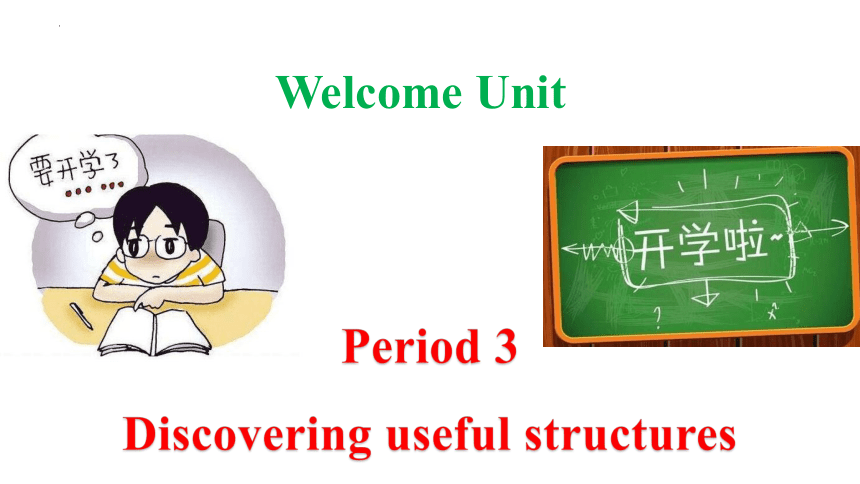 | |
| 格式 | ppt | ||
| 文件大小 | 5.3MB | ||
| 资源类型 | 教案 | ||
| 版本资源 | 人教版(2019) | ||
| 科目 | 英语 | ||
| 更新时间 | 2022-11-05 09:23:50 | ||
图片预览

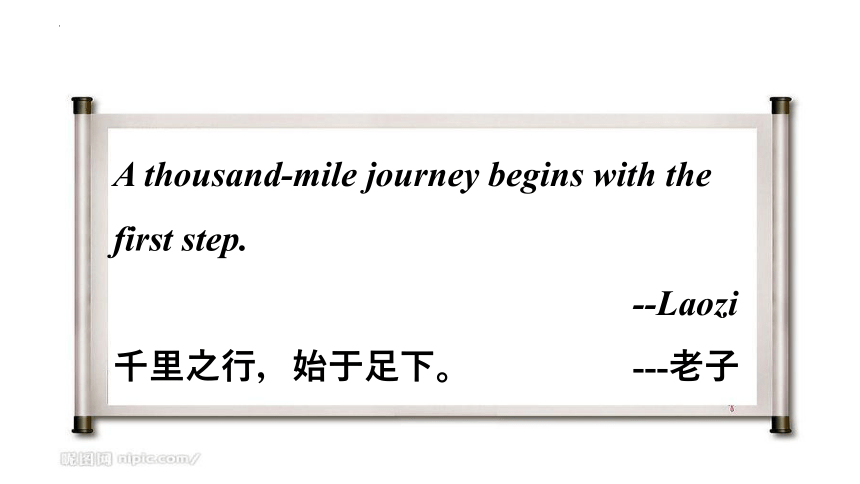
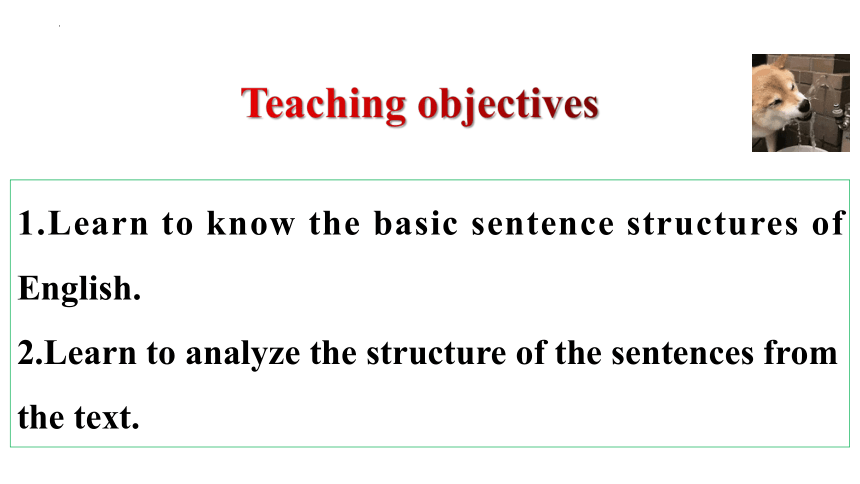
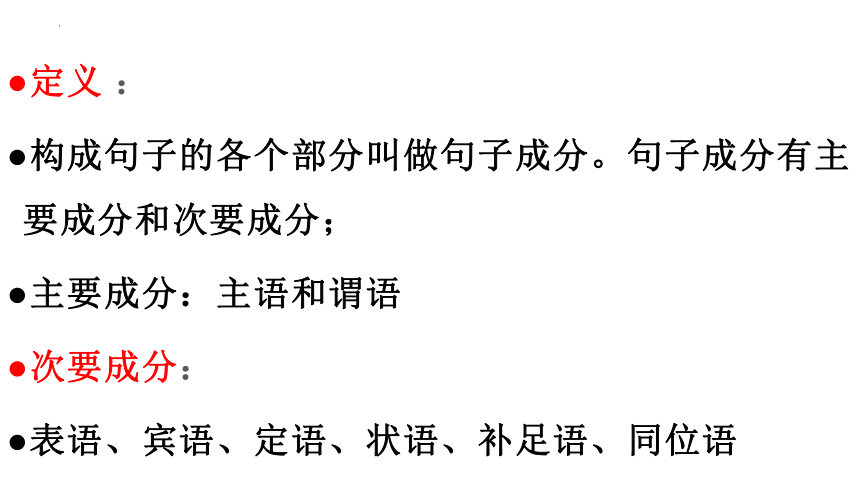
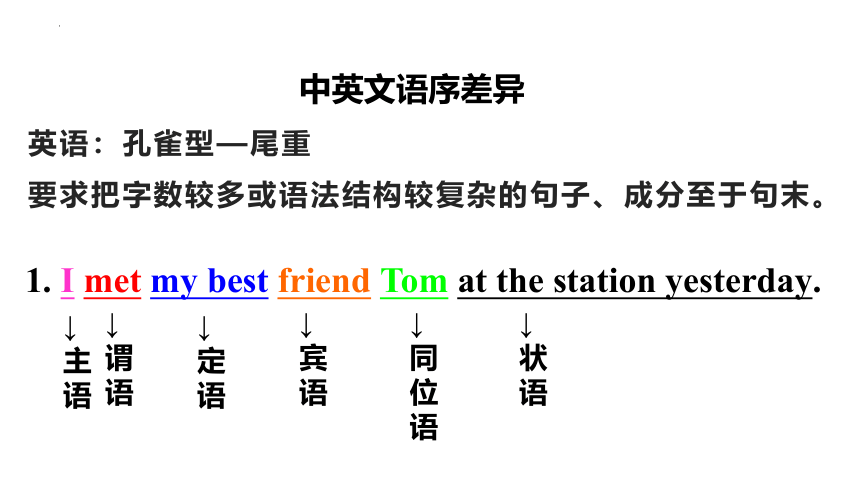
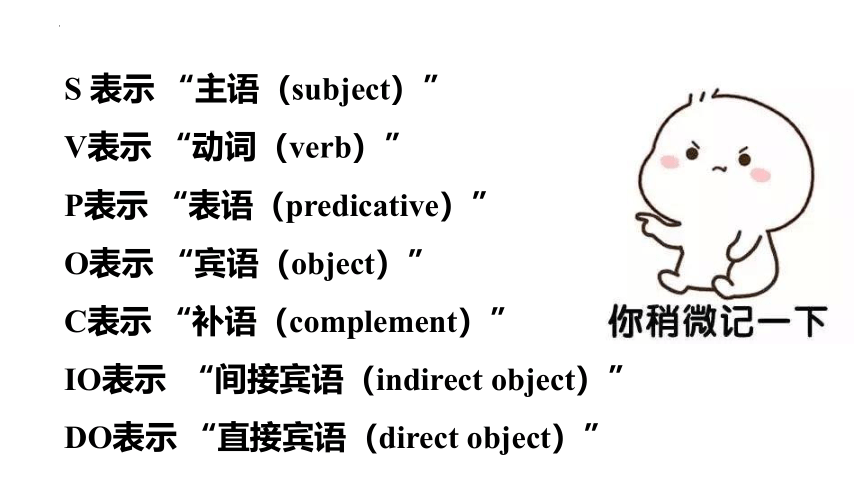
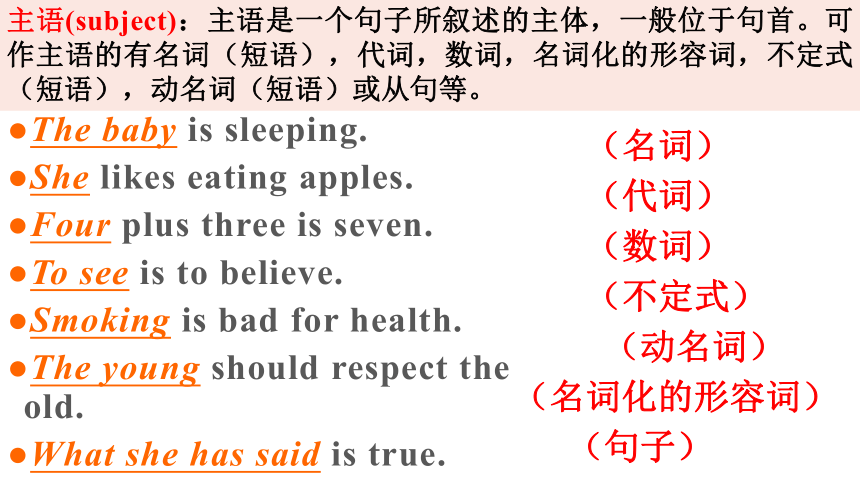
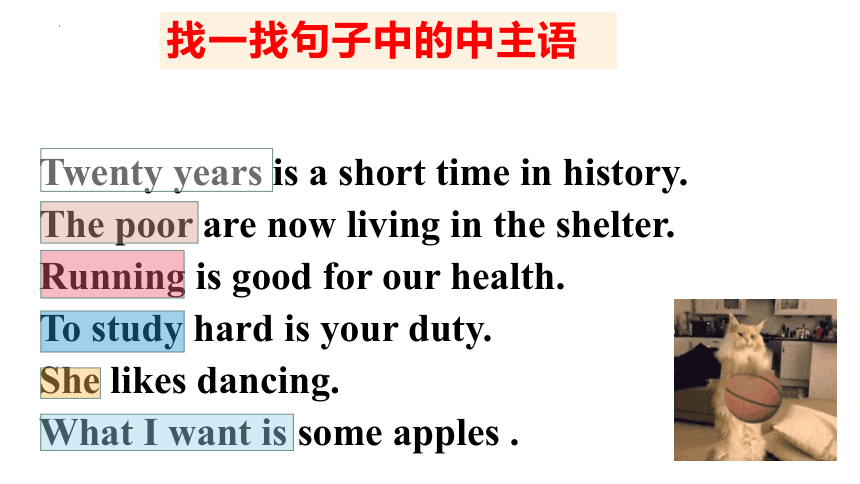
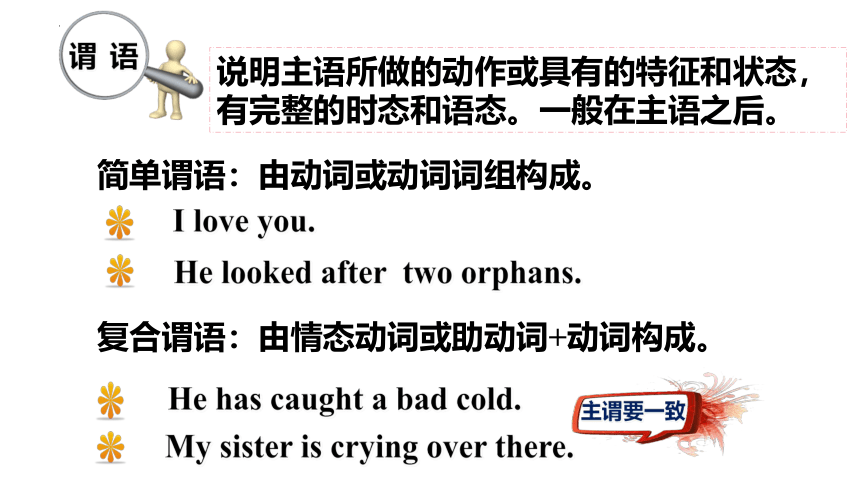
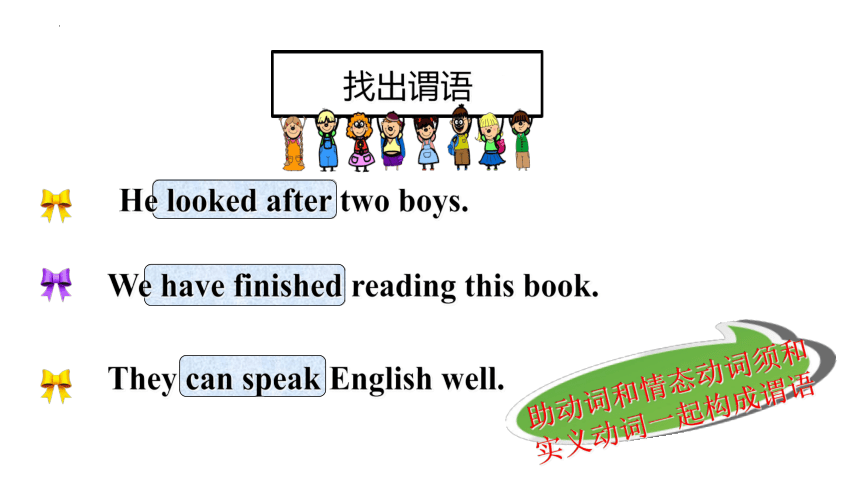
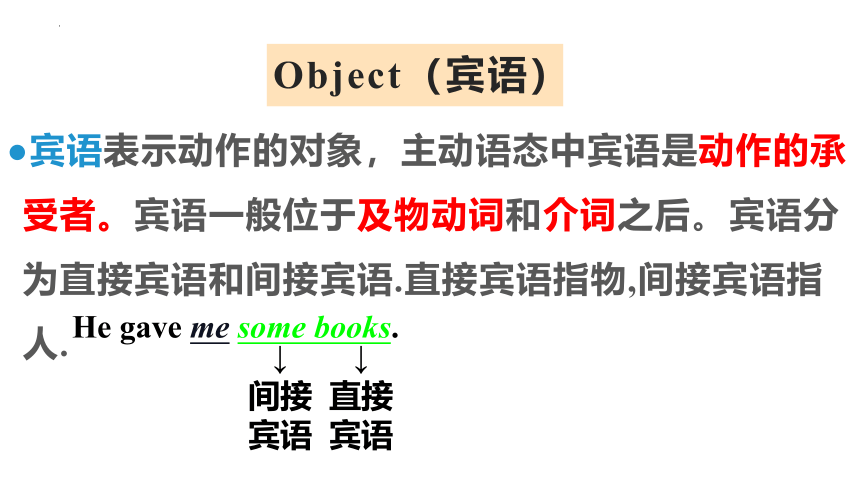
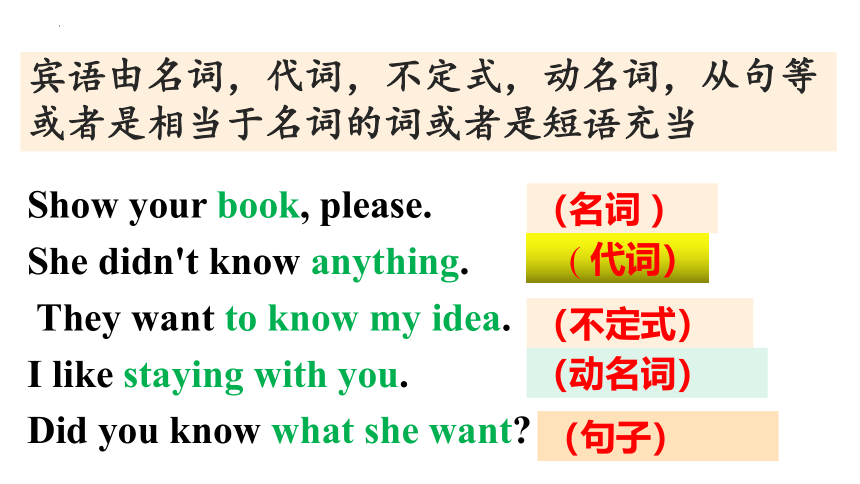
文档简介
(共39张PPT)
Welcome Unit
Period 3
Discovering useful structures
A thousand-mile journey begins with the first step.
--Laozi
千里之行,始于足下。 ---老子
1.Learn to know the basic sentence structures of English.
2.Learn to analyze the structure of the sentences from the text.
定义 :
构成句子的各个部分叫做句子成分。句子成分有主要成分和次要成分;
主要成分:主语和谓语
次要成分:
表语、宾语、定语、状语、补足语、同位语
1. I met my best friend Tom at the station yesterday.
↓
主语
↓
谓
语
↓
定语
↓
宾
语
↓
同位语
↓
状
语
中英文语序差异
英语:孔雀型—尾重
要求把字数较多或语法结构较复杂的句子、成分至于句末。
S 表示 “主语(subject)”
V表示 “动词(verb)”
P表示 “表语(predicative)”
O表示 “宾语(object)”
C表示 “补语(complement)”
IO表示 “间接宾语(indirect object)”
DO表示 “直接宾语(direct object)”
The baby is sleeping.
She likes eating apples.
Four plus three is seven.
To see is to believe.
Smoking is bad for health.
The young should respect the old.
What she has said is true.
(名词)
(代词)
(数词)
(不定式)
(动名词)
(名词化的形容词)
(句子)
主语(subject):主语是一个句子所叙述的主体,一般位于句首。可作主语的有名词(短语),代词,数词,名词化的形容词,不定式(短语),动名词(短语)或从句等。
找一找句子中的中主语
Twenty years is a short time in history.
The poor are now living in the shelter.
Running is good for our health.
To study hard is your duty.
She likes dancing.
What I want is some apples .
主谓要一致
谓 语
I love you.
He has caught a bad cold.
说明主语所做的动作或具有的特征和状态,有完整的时态和语态。一般在主语之后。
He looked after two orphans.
简单谓语:由动词或动词词组构成。
复合谓语:由情态动词或助动词+动词构成。
My sister is crying over there.
We have finished reading this book.
They can speak English well.
助动词和情态动词须和
实义动词一起构成谓语
He looked after two boys.
找出谓语
Object(宾语)
宾语表示动作的对象,主动语态中宾语是动作的承受者。宾语一般位于及物动词和介词之后。宾语分为直接宾语和间接宾语.直接宾语指物,间接宾语指人.
He gave me some books.
↓
间接
宾语
↓
直接
宾语
宾语由名词,代词,不定式,动名词,从句等或者是相当于名词的词或者是短语充当
(句子)
Show your book, please.
She didn't know anything.
They want to know my idea.
I like staying with you.
Did you know what she want
(名词 )
( 代词)
(不定式)
(动名词)
表 语
表 语
Her mother is a teacher.
主
系动词
表
The flower smells sweet.
Seeing is believing.
位于系动词之后,表示主语“是什么”或“怎么样”。
系动词起连接主语和表语作用,本身有一定词义,它和实义动词一样有时态变化,也受主语人称和数的影响。
常见系动词:
be (am/is/are/was/were);
感官:smell, sound, taste, look, seem, feel(摸起来), appear;
变得:become/get/grow/turn/fall(变得) ;
保持:remain (仍然是) ,keep/stay;
不定式作表语 Her dream is to become a dancer.
动名词作表语 Her job is selling computers.
分词作表语 The problem is pressing. (现在分词)
The door remains locked.(过去分词)
介词短语作表语 The patient is out of danger.
从句作宾语 This is what he said.
名词作表语 China is a big country.
代词作表语 The book is mine.
形容词作表语 I feel much better today.
副词作表语 I was here.
数词作表语 Five and four is nine.
找出表语
Everything looks nice.
His face turned red.
He is happy.
I found the book interesting.
Do you smell something burning
He made himself known to them.
She asked me to lend her a hand.
Please make yourself at home.
Please keep the dog out.
We must keep it a secret.
宾语补足语
英语中有些及物动词接宾语后,意义仍然不完整,还需要一个句子成分来补充说明宾语的意义,状态等,这就是宾语补足语。
He is a clever boy.
His father works in a steel work.
There are 54students in our class.
Do you known betty’s sister
He bought some sleepingpills.
There is a sleeping baby in bed.
His spoken language is good.
(形容词)
(名词)
(数词)
(名词的所有格)
(动名词)
(现在分词)
(过去分词)
定语
定语是对名词或代词起修饰,限定作用的句子成分。
I will be back in a while.
They are playing on the playground.
He was late because he got up late.
He got up so late that I missed the train.
状语
用于修饰形容词,副词,动词,介词短语或句子.可表示时间,地点,原因,结果,目的,方式,伴随,条件,程度,让步,频率等。
S+V(主谓)
S+V+O(主谓宾)
S+V+O+O(主谓间宾直宾)
S+V+O+C(主谓宾宾补)
五大基本句型
S+V+P(主系表)
基本句型 一
S(subject) +V(verb)(主+谓)
特点:句子的谓语动词都能表达完整的意思。
这类动词叫做不及物动词,后面可以跟副词、介词短语、状语从句等。即:后面不可以直接跟宾语,但可以加介词再加宾语
S V (不及物动词)
1. Time
2. The moon
3. We all
4. They
5. He
6. He
7. They flies.
rose.
eat, and drink.
talked for half an hour.
walked yesterday.
is playing.
listens to classical music..
不及物动词后面不可直接加宾语。如需要加宾语,需要添加介词
基本句型 二
S +V +O(主+谓+宾)
特点:宾语表示动作的对象或行为的承受者,一般位于及物动词(短语)和介词后面,一般由名词、代词、数词、动词不定式(短语)、动名词(短语)等充当。
S V(实义动词) O(宾语)
1. Who
2. She
3. He
4. He
5. They
6. Danny
7. I
8. He knows
laughs at
understands
made
ate
likes
want
said the answer
her.
English.
cakes.
some apples.
donuts.
to have a cup of tea.
"Good morning."
基本句型 三
S +V +P(主+系+表)
此句型的句子有一个共同的特点:句子的系动词都不能表达一个完整的意思,必须加上一个表明主语身份或状
态的表语,才能表达完整的意思。表语多为形容词,也可以是名词、介词短语、动名词等。
S V P(表语)
1. This
2. The dinner
3. He
4. Everything
5. He
6. The book
7. The weather
8. His face is
smells(闻)
fell
looks
is
is
became
turned an English dictionary.
good.
happy.
different.
tall and strong.
interesting.
warmer.
red.
基本句型 四
S +V +IO +DO(主+谓+间宾+直宾)
此句型的句子有一个共同特点:谓语动词后面必须有两个宾语才能表达完整的意思。这两个宾语一个是动作的直接承受者(物),另一个是动作的间接承受者(人)。
S V(及物) o(多指人) O(多指物)
1. She
2. She
3. He
4. He
5. I
6. I
7. I
8. He passed
cooked
brought
bought
showed
gave
told
showed him
her husband
you
her
him
him
me a new dress.
a delicious meal.
a dictionary.
nothing.
my pictures.
a hand.
how to run the machine.
that the bus was late.
可接双宾语的38个常用动词
(1) 双宾语易位时需借助介词to的常用动词
award sb. sth. = award sth. to sb. 颁奖给某人
bring sb. sth. = bring sth. to sb. 把某物带给某人
hand sb. sth. =hand sth. to sb. 把某物递给某人
lend sb. sth. = lend sth. to sb. 把某物借给某人
mail sb. sth. = mail sth. to sb. 把某物寄给某人
offer sb. sth. = offer sth. to sb. 将某物给某人
owe sb. sth. = owe sth. to sb. 欠某人某物
pass sb. sth. = pass sth. to sb. 把某物递给某人
book sb. sth. = book sth. for sb. 为某人预定某物
buy sb. sth. = buy sth. for sb. 为某人买某物
choose sb. sth. = choose sth. for sb. 为某人选某物
cook sb. sth. = cook sth. for sb. 为某人煮某物
fetch sb. sth. = fetch sth. for sb. 为某人去取某物
find sb. sth. = find sth. for sb. 为某人找到某物
fix sb. sth. = fix sth. for sb. 为某人准备某物
get sb. sth. = get sth. for sb. 为某人拿来某物
make sb. sth. = make sth. for sb. 为某人做某物
order sb. sth. = order sth. for sb. 为某人订购某物
pick sb. sth. = pick sth. for sb. 为某人采摘某物
prepare sb. sth. = prepare sth. for sb. 为某人准备某物
save sb. sth. = save sth. for sb. 为某人留某物
sing sb. sth. = sing sth. for sb. 为某人唱某物(歌)
spare sb. sth. = spare sth. for sb. 为某人让出某物
steal sb. sth. = steal sth. for sb. 为某人偷某物
基本句型 五
S +V +O +C(主+谓+宾+宾补)
此句型的句子的共同特点是:动词虽然是及物动词,但是只跟一个宾语还不能表达完整的意思,必须加上一个补充成分来补足宾语,才能使意思完整。
S V(及物) O(宾语) C(宾补)
1. We
2. They
3. They
4. They
5. What
6. We
7. He
8. I keep
painted
call
found
makes
saw
asked
saw the table
the door
supper
the house
him
him
me
them clean.
green.
dinner.
dirty.
sad
out.
to come back soon.
getting on the bus.
【语境应用】判断句子结构类型。
1) Everybody smiled.
2) The car caught fire.
3) Did the milk turn sour
4) He bought his wife a dress.
5) Roy found his new job rather boring.
6) Your brother got up at 10 o’clock.
7) I haven’t seen Daniel for long.
SVOC
SVA
SVOA
SV
SVO
SP
SVIODO
翻译练习:
1. 他们走着,笑着。
2. 英语老师很友好。
3. 树上有一只可爱的小鸟。
4. 他给她妹妹买了一架钢琴。
5. 老师发现教室是空的。
They walked and laughed.
The English teacher is friendly.
There is a lovely bird in the tree.
He bought his sister a piano.
The teacher found the classroom empty.
翻译练习:
6. 我听到她正在唱歌。
7. 英语作业看上去很简单。
8. 我们笑得很开心。
9. 我们学校有许多学生。
10. 她是一个爱交际的女孩。
I heard her singing a song.
The English homework looks easy.
We laugh happily.
There are many students in our school.
She is an outgoing girl.
翻译下列句子并分析句子结构。
比赛中友谊第一。(19年全国卷)
你能考虑我的申请,我将不胜感激。(19全国卷)
从生活到日常训练,我们队正在为比赛做准备。(19全国卷)
中国传统服装看起来更漂亮,更时尚。(19江苏)
它一直都给予我面对生活中挑战的力量。(18全国卷)
即将到来的音乐节将在我们学校举行。(19全国卷)
我真诚地邀请你亲自来我们学校看看。
1. 比赛中友谊第一。(19年全国卷)
Friendship always comes first in the competition.
2. 你能考虑我的申请,我将不胜感激。(19全国卷)
I would appreciate it if you can take my application into consideration
3. 从生活到日常训练,我们队正在为比赛做准备。(19全国卷)
Our team are preparing for the competition, from living to daily training.
4. 中国传统服装看起来更漂亮,更时尚。(19江苏)
Traditional Chinese dress looks more beautiful and fashionable.
5. 它一直都给予我面对生活中挑战的力量。(18全国卷)
It always gives me the strength to confront the challenges in my life.
6. 即将到来的音乐节将在我们学校举行。(19全国卷)
The coming Music Festival will be held in our school.
7. 我真诚地邀请你亲自来我们学校看看.
I sincerely invite you to come to our school to have a look for yourself.
Welcome Unit
Period 3
Discovering useful structures
A thousand-mile journey begins with the first step.
--Laozi
千里之行,始于足下。 ---老子
1.Learn to know the basic sentence structures of English.
2.Learn to analyze the structure of the sentences from the text.
定义 :
构成句子的各个部分叫做句子成分。句子成分有主要成分和次要成分;
主要成分:主语和谓语
次要成分:
表语、宾语、定语、状语、补足语、同位语
1. I met my best friend Tom at the station yesterday.
↓
主语
↓
谓
语
↓
定语
↓
宾
语
↓
同位语
↓
状
语
中英文语序差异
英语:孔雀型—尾重
要求把字数较多或语法结构较复杂的句子、成分至于句末。
S 表示 “主语(subject)”
V表示 “动词(verb)”
P表示 “表语(predicative)”
O表示 “宾语(object)”
C表示 “补语(complement)”
IO表示 “间接宾语(indirect object)”
DO表示 “直接宾语(direct object)”
The baby is sleeping.
She likes eating apples.
Four plus three is seven.
To see is to believe.
Smoking is bad for health.
The young should respect the old.
What she has said is true.
(名词)
(代词)
(数词)
(不定式)
(动名词)
(名词化的形容词)
(句子)
主语(subject):主语是一个句子所叙述的主体,一般位于句首。可作主语的有名词(短语),代词,数词,名词化的形容词,不定式(短语),动名词(短语)或从句等。
找一找句子中的中主语
Twenty years is a short time in history.
The poor are now living in the shelter.
Running is good for our health.
To study hard is your duty.
She likes dancing.
What I want is some apples .
主谓要一致
谓 语
I love you.
He has caught a bad cold.
说明主语所做的动作或具有的特征和状态,有完整的时态和语态。一般在主语之后。
He looked after two orphans.
简单谓语:由动词或动词词组构成。
复合谓语:由情态动词或助动词+动词构成。
My sister is crying over there.
We have finished reading this book.
They can speak English well.
助动词和情态动词须和
实义动词一起构成谓语
He looked after two boys.
找出谓语
Object(宾语)
宾语表示动作的对象,主动语态中宾语是动作的承受者。宾语一般位于及物动词和介词之后。宾语分为直接宾语和间接宾语.直接宾语指物,间接宾语指人.
He gave me some books.
↓
间接
宾语
↓
直接
宾语
宾语由名词,代词,不定式,动名词,从句等或者是相当于名词的词或者是短语充当
(句子)
Show your book, please.
She didn't know anything.
They want to know my idea.
I like staying with you.
Did you know what she want
(名词 )
( 代词)
(不定式)
(动名词)
表 语
表 语
Her mother is a teacher.
主
系动词
表
The flower smells sweet.
Seeing is believing.
位于系动词之后,表示主语“是什么”或“怎么样”。
系动词起连接主语和表语作用,本身有一定词义,它和实义动词一样有时态变化,也受主语人称和数的影响。
常见系动词:
be (am/is/are/was/were);
感官:smell, sound, taste, look, seem, feel(摸起来), appear;
变得:become/get/grow/turn/fall(变得) ;
保持:remain (仍然是) ,keep/stay;
不定式作表语 Her dream is to become a dancer.
动名词作表语 Her job is selling computers.
分词作表语 The problem is pressing. (现在分词)
The door remains locked.(过去分词)
介词短语作表语 The patient is out of danger.
从句作宾语 This is what he said.
名词作表语 China is a big country.
代词作表语 The book is mine.
形容词作表语 I feel much better today.
副词作表语 I was here.
数词作表语 Five and four is nine.
找出表语
Everything looks nice.
His face turned red.
He is happy.
I found the book interesting.
Do you smell something burning
He made himself known to them.
She asked me to lend her a hand.
Please make yourself at home.
Please keep the dog out.
We must keep it a secret.
宾语补足语
英语中有些及物动词接宾语后,意义仍然不完整,还需要一个句子成分来补充说明宾语的意义,状态等,这就是宾语补足语。
He is a clever boy.
His father works in a steel work.
There are 54students in our class.
Do you known betty’s sister
He bought some sleepingpills.
There is a sleeping baby in bed.
His spoken language is good.
(形容词)
(名词)
(数词)
(名词的所有格)
(动名词)
(现在分词)
(过去分词)
定语
定语是对名词或代词起修饰,限定作用的句子成分。
I will be back in a while.
They are playing on the playground.
He was late because he got up late.
He got up so late that I missed the train.
状语
用于修饰形容词,副词,动词,介词短语或句子.可表示时间,地点,原因,结果,目的,方式,伴随,条件,程度,让步,频率等。
S+V(主谓)
S+V+O(主谓宾)
S+V+O+O(主谓间宾直宾)
S+V+O+C(主谓宾宾补)
五大基本句型
S+V+P(主系表)
基本句型 一
S(subject) +V(verb)(主+谓)
特点:句子的谓语动词都能表达完整的意思。
这类动词叫做不及物动词,后面可以跟副词、介词短语、状语从句等。即:后面不可以直接跟宾语,但可以加介词再加宾语
S V (不及物动词)
1. Time
2. The moon
3. We all
4. They
5. He
6. He
7. They flies.
rose.
eat, and drink.
talked for half an hour.
walked yesterday.
is playing.
listens to classical music..
不及物动词后面不可直接加宾语。如需要加宾语,需要添加介词
基本句型 二
S +V +O(主+谓+宾)
特点:宾语表示动作的对象或行为的承受者,一般位于及物动词(短语)和介词后面,一般由名词、代词、数词、动词不定式(短语)、动名词(短语)等充当。
S V(实义动词) O(宾语)
1. Who
2. She
3. He
4. He
5. They
6. Danny
7. I
8. He knows
laughs at
understands
made
ate
likes
want
said the answer
her.
English.
cakes.
some apples.
donuts.
to have a cup of tea.
"Good morning."
基本句型 三
S +V +P(主+系+表)
此句型的句子有一个共同的特点:句子的系动词都不能表达一个完整的意思,必须加上一个表明主语身份或状
态的表语,才能表达完整的意思。表语多为形容词,也可以是名词、介词短语、动名词等。
S V P(表语)
1. This
2. The dinner
3. He
4. Everything
5. He
6. The book
7. The weather
8. His face is
smells(闻)
fell
looks
is
is
became
turned an English dictionary.
good.
happy.
different.
tall and strong.
interesting.
warmer.
red.
基本句型 四
S +V +IO +DO(主+谓+间宾+直宾)
此句型的句子有一个共同特点:谓语动词后面必须有两个宾语才能表达完整的意思。这两个宾语一个是动作的直接承受者(物),另一个是动作的间接承受者(人)。
S V(及物) o(多指人) O(多指物)
1. She
2. She
3. He
4. He
5. I
6. I
7. I
8. He passed
cooked
brought
bought
showed
gave
told
showed him
her husband
you
her
him
him
me a new dress.
a delicious meal.
a dictionary.
nothing.
my pictures.
a hand.
how to run the machine.
that the bus was late.
可接双宾语的38个常用动词
(1) 双宾语易位时需借助介词to的常用动词
award sb. sth. = award sth. to sb. 颁奖给某人
bring sb. sth. = bring sth. to sb. 把某物带给某人
hand sb. sth. =hand sth. to sb. 把某物递给某人
lend sb. sth. = lend sth. to sb. 把某物借给某人
mail sb. sth. = mail sth. to sb. 把某物寄给某人
offer sb. sth. = offer sth. to sb. 将某物给某人
owe sb. sth. = owe sth. to sb. 欠某人某物
pass sb. sth. = pass sth. to sb. 把某物递给某人
book sb. sth. = book sth. for sb. 为某人预定某物
buy sb. sth. = buy sth. for sb. 为某人买某物
choose sb. sth. = choose sth. for sb. 为某人选某物
cook sb. sth. = cook sth. for sb. 为某人煮某物
fetch sb. sth. = fetch sth. for sb. 为某人去取某物
find sb. sth. = find sth. for sb. 为某人找到某物
fix sb. sth. = fix sth. for sb. 为某人准备某物
get sb. sth. = get sth. for sb. 为某人拿来某物
make sb. sth. = make sth. for sb. 为某人做某物
order sb. sth. = order sth. for sb. 为某人订购某物
pick sb. sth. = pick sth. for sb. 为某人采摘某物
prepare sb. sth. = prepare sth. for sb. 为某人准备某物
save sb. sth. = save sth. for sb. 为某人留某物
sing sb. sth. = sing sth. for sb. 为某人唱某物(歌)
spare sb. sth. = spare sth. for sb. 为某人让出某物
steal sb. sth. = steal sth. for sb. 为某人偷某物
基本句型 五
S +V +O +C(主+谓+宾+宾补)
此句型的句子的共同特点是:动词虽然是及物动词,但是只跟一个宾语还不能表达完整的意思,必须加上一个补充成分来补足宾语,才能使意思完整。
S V(及物) O(宾语) C(宾补)
1. We
2. They
3. They
4. They
5. What
6. We
7. He
8. I keep
painted
call
found
makes
saw
asked
saw the table
the door
supper
the house
him
him
me
them clean.
green.
dinner.
dirty.
sad
out.
to come back soon.
getting on the bus.
【语境应用】判断句子结构类型。
1) Everybody smiled.
2) The car caught fire.
3) Did the milk turn sour
4) He bought his wife a dress.
5) Roy found his new job rather boring.
6) Your brother got up at 10 o’clock.
7) I haven’t seen Daniel for long.
SVOC
SVA
SVOA
SV
SVO
SP
SVIODO
翻译练习:
1. 他们走着,笑着。
2. 英语老师很友好。
3. 树上有一只可爱的小鸟。
4. 他给她妹妹买了一架钢琴。
5. 老师发现教室是空的。
They walked and laughed.
The English teacher is friendly.
There is a lovely bird in the tree.
He bought his sister a piano.
The teacher found the classroom empty.
翻译练习:
6. 我听到她正在唱歌。
7. 英语作业看上去很简单。
8. 我们笑得很开心。
9. 我们学校有许多学生。
10. 她是一个爱交际的女孩。
I heard her singing a song.
The English homework looks easy.
We laugh happily.
There are many students in our school.
She is an outgoing girl.
翻译下列句子并分析句子结构。
比赛中友谊第一。(19年全国卷)
你能考虑我的申请,我将不胜感激。(19全国卷)
从生活到日常训练,我们队正在为比赛做准备。(19全国卷)
中国传统服装看起来更漂亮,更时尚。(19江苏)
它一直都给予我面对生活中挑战的力量。(18全国卷)
即将到来的音乐节将在我们学校举行。(19全国卷)
我真诚地邀请你亲自来我们学校看看。
1. 比赛中友谊第一。(19年全国卷)
Friendship always comes first in the competition.
2. 你能考虑我的申请,我将不胜感激。(19全国卷)
I would appreciate it if you can take my application into consideration
3. 从生活到日常训练,我们队正在为比赛做准备。(19全国卷)
Our team are preparing for the competition, from living to daily training.
4. 中国传统服装看起来更漂亮,更时尚。(19江苏)
Traditional Chinese dress looks more beautiful and fashionable.
5. 它一直都给予我面对生活中挑战的力量。(18全国卷)
It always gives me the strength to confront the challenges in my life.
6. 即将到来的音乐节将在我们学校举行。(19全国卷)
The coming Music Festival will be held in our school.
7. 我真诚地邀请你亲自来我们学校看看.
I sincerely invite you to come to our school to have a look for yourself.
